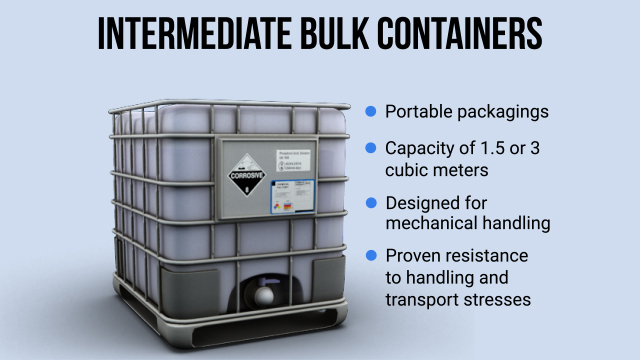




DOT Hazmat – Packaging
The primary function of hazmat packaging is to ensure that hazardous materials remain intact and secure during transportation. All packagings must be designed to ensure that under normal conditions, the contents will not be released and the packaging effectiveness will be maintained as it experiences typical physical stresses, including shocks, vibrations, temperature extremes, and changes in humidity and pressure. The Hazardous Materials Table (HMT) in Section 172.101 of the HMR can be used to determine the non-bulk and bulk packaging requirements, and any conditions for packaging exceptions, for hazardous material shipments.
Request a demoCourse Details
Learning Objectives
• Define the terms “hazardous material,” “dangerous goods,” “packaging,” “package,” “limited quantity,” “excepted quantity,” and “consumer commodity” • Describe “bulk,” “non-bulk,” “combination,” “composite,” “single,” “large,” and “salvage” packagings • Identify when the Hazardous Materials Regulations, IMDG Code, IATA Dangerous Goods Regulations, and UN Recommendations apply • Demonstrate how to determine packaging exceptions and authorized packagings, and how to apply Special Provisions • Describe the purpose and application of DOT Special Permits • Show how Packing Group performance levels in UN POP marks are applied • List general HMR packaging requirements and common exceptions • Identify where the requirements for limited quantity and excepted quantity shipments can be found
Specs
| Course Level | Intermediate |
| Languages | English |
| Compatibility | Audio, Video |
| Based on: | HMR General Requirements for Shipments and Packagings, 49 CFR § 173 |
Key Questions
What is the difference between the terms “package” and “packaging”?
“Packaging” refers to the primary receptacle plus other materials needed to contain the material in the receptacle, and “package” refers to the packaging plus its contents.
What does it take to get a DOT Special Permit if I want a variance to the HMR requirements?
Permit applicants must prove to the PHMSA that their alternative will achieve the same safety level as the HMR or is consistent with the public interest (in emergency situations, for example).
What does it mean if the Hazardous Materials Table says “Forbidden” in Column 9A, (for passenger aircraft and rail shipments)?
This means that the material may not be offered for transport aboard passenger aircraft or passenger rail.
What is an overpack?
An overpack is an enclosure that a shipper can use to contain one or more packages and form a single unit for the purpose of convenience.
Can hazmat packagings be reused?
Generally speaking, bulk and non-bulk packagings may be reused as long as they are in good condition and still comply with all applicable HMR requirements.
Sample Video Transcript
The Hazardous Materials Table (HMT) in Section 172.101 of the HMR can be used to determine the non-bulk and bulk packaging requirements, and any conditions for packaging exceptions, for hazardous material shipments. These requirements are based on the Hazard Class or Division, Packing Group (if applicable), and total quantity of the material being shipped. Packaging exceptions and requirements are detailed in sections of the HMR that are referenced in Columns 8A, 8B, 8C. The entries in these columns refer to sections in Part 173 of the HMR.
Course Applies To
Demos + Pricing
Learn more about our courses, get pricing, and see our platform.











